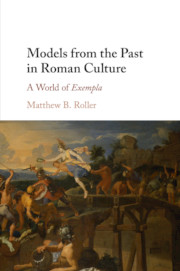Refine search
Actions for selected content:
23990 results in Ancient history
Abbreviations
-
- Book:
- Models from the Past in Roman Culture
- Published online:
- 21 March 2018
- Print publication:
- 22 March 2018, pp xiv-xv
-
- Chapter
- Export citation
Chapter 2 - Cloelia
-
- Book:
- Models from the Past in Roman Culture
- Published online:
- 21 March 2018
- Print publication:
- 22 March 2018, pp 66-94
-
- Chapter
- Export citation
Chapter 8 - Conclusion
-
- Book:
- Models from the Past in Roman Culture
- Published online:
- 21 March 2018
- Print publication:
- 22 March 2018, pp 265-289
-
- Chapter
- Export citation
Chapter 3 - Appius Claudius Caecus
-
- Book:
- Models from the Past in Roman Culture
- Published online:
- 21 March 2018
- Print publication:
- 22 March 2018, pp 95-133
-
- Chapter
- Export citation
General Index
-
- Book:
- Models from the Past in Roman Culture
- Published online:
- 21 March 2018
- Print publication:
- 22 March 2018, pp 316-322
-
- Chapter
- Export citation
Illustrations
-
- Book:
- Models from the Past in Roman Culture
- Published online:
- 21 March 2018
- Print publication:
- 22 March 2018, pp x-x
-
- Chapter
- Export citation
Dedication
-
- Book:
- Models from the Past in Roman Culture
- Published online:
- 21 March 2018
- Print publication:
- 22 March 2018, pp v-vi
-
- Chapter
- Export citation
Chapter 5 - Fabius Cunctator
-
- Book:
- Models from the Past in Roman Culture
- Published online:
- 21 March 2018
- Print publication:
- 22 March 2018, pp 163-196
-
- Chapter
- Export citation
Bibliography
-
- Book:
- Models from the Past in Roman Culture
- Published online:
- 21 March 2018
- Print publication:
- 22 March 2018, pp 290-312
-
- Chapter
- Export citation
Chapter 1 - Horatius Cocles
-
- Book:
- Models from the Past in Roman Culture
- Published online:
- 21 March 2018
- Print publication:
- 22 March 2018, pp 32-65
-
- Chapter
- Export citation
Acknowledgments
-
- Book:
- Models from the Past in Roman Culture
- Published online:
- 21 March 2018
- Print publication:
- 22 March 2018, pp xi-xiii
-
- Chapter
- Export citation
Chapter 7 - Cicero’s House and “Aspiring to Kingship”
-
- Book:
- Models from the Past in Roman Culture
- Published online:
- 21 March 2018
- Print publication:
- 22 March 2018, pp 233-264
-
- Chapter
- Export citation
Copyright page
-
- Book:
- Models from the Past in Roman Culture
- Published online:
- 21 March 2018
- Print publication:
- 22 March 2018, pp iv-iv
-
- Chapter
- Export citation
Introduction
-
- Book:
- Models from the Past in Roman Culture
- Published online:
- 21 March 2018
- Print publication:
- 22 March 2018, pp 1-31
-
- Chapter
- Export citation
Map of the Principal Monuments and Sites Discussed in This Book
-
- Book:
- Models from the Past in Roman Culture
- Published online:
- 21 March 2018
- Print publication:
- 22 March 2018, pp xvi-xx
-
- Chapter
- Export citation
Index Locorum
-
- Book:
- Models from the Past in Roman Culture
- Published online:
- 21 March 2018
- Print publication:
- 22 March 2018, pp 313-315
-
- Chapter
- Export citation
Contents
-
- Book:
- Models from the Past in Roman Culture
- Published online:
- 21 March 2018
- Print publication:
- 22 March 2018, pp vii-ix
-
- Chapter
- Export citation

Models from the Past in Roman Culture
- A World of Exempla
-
- Published online:
- 21 March 2018
- Print publication:
- 22 March 2018
Introduction. The End of the West Roman Empire: From Decline and Fall to Transformation of the Roman World
-
- Book:
- The Transformation of the Roman West
- Published by:
- Amsterdam University Press
- Published online:
- 15 January 2021
- Print publication:
- 28 February 2018, pp 1-14
-
- Chapter
- Export citation
Chapter 5 - Religious Reaction to the Fall of Rome
-
- Book:
- The Transformation of the Roman West
- Published by:
- Amsterdam University Press
- Published online:
- 15 January 2021
- Print publication:
- 28 February 2018, pp 43-46
-
- Chapter
- Export citation
